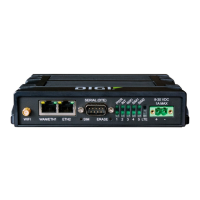Virtual PrivateNetworks(VPN) IPsec
IX20 User Guide
489
i. Click next to Add Hostname.
ii. For Hostname, type a hostname or IPv4 address. If your device isnot configured to
initiate the IPsec connection (see IKE> Initiate connection), you can also use the
keyword any, which meansthat the hostname is dynamic or unknown.
iii. Click again to add additional hostnames.
d. Click to expand ID.
i. Select the IDtype:
n
Auto: The IDwill be automatically determined from the value of the tunnels
endpoints.
n
Raw: Enter an ID and have it passed unmodified to the underlying IPsec stack.
For Raw ID value, typethe IDthat will be passed.
n
Any: Any IDwill be accepted.
n
IPv4: The IDwill be interpreted as an IPv4 address and sent as an ID_IPV4_
ADDRIKEidentity.
For IPv4 ID value, type an IPv4 formatted ID. Thiscan be a fully-qualified
domain name or an IPv4 address.
n
IPv6: The IDwill be interpreted as an IPv6 address and sent as an ID_IPV6_
ADDRIKEidentity.
For IPv6 ID value, type an IPv6 formatted ID. Thiscan be a fully-qualified
domain name or an IPv6 address.
n
RFC822/Email: TheIDwill be interpreted as an RFC822 (email address).
For RFC822 ID value, type the ID in internet email addressformat.
n
FQDN: The IDwill be interpreted as FQDN(Fully Qualified Domain Name) and
sent as an ID_FQDN IKEidentity.
For FQDN ID value, type the ID as an FQDN.
n
KeyID: The IDwill be interpreted as a Key IDand sent as an ID_KEY_IDIKE
identity.
For KEYID ID value, type the key ID.
n
MAC address: The device's primary MAC addresswill be used as the IDand
sent as a ID_KEY_IDIKE identity.
n
Serial number: The device's serial number will be used as the IDand sent as a
ID_KEY_IDIKE identity.
21. Click to expand Policies.
Policiesdefine the network traffic that will be encapsulated by thistunnel.
a. Click to create a new policy.
The new policy configuration is displayed.

